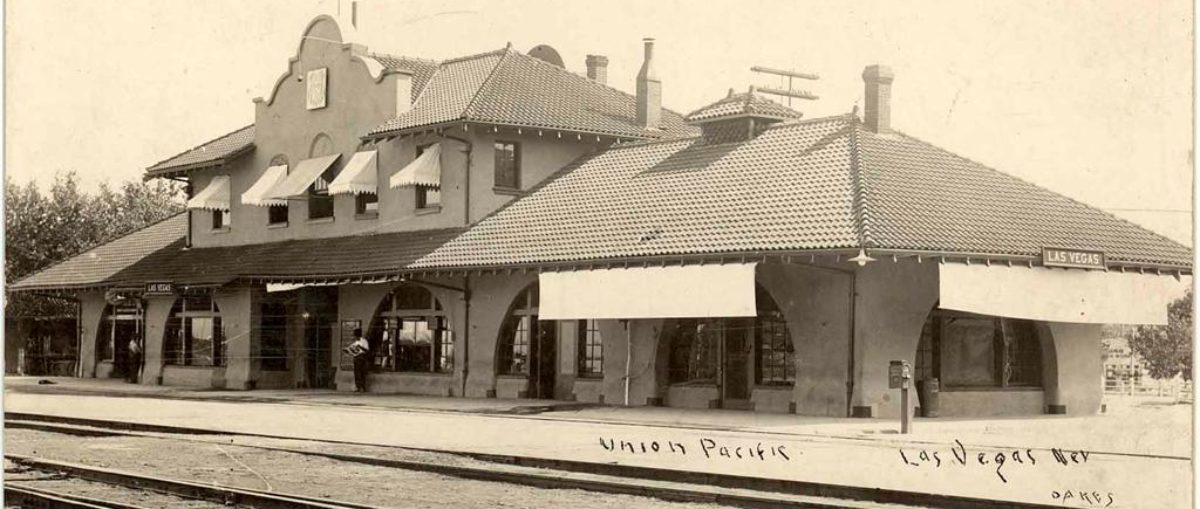With the end of World War II, and the development of the soon to be named “Las Vegas Strip” two magazines, popped up off and on for several months between 1945 and 1947. One was Nevada Life, when it folded a second, looking, at least on the cover like the first, was called Las Vegas Life. Its publisher Hank Greenspun. More research, more interviews, more details need to be uncovered, and here are is a set of the current notes.
The most popular magazine in the United State in 1945 was Life Magazine.
With a “Life” in red, the first edition of Nevada Life magazine was published in Las Vegas in September of 1945.
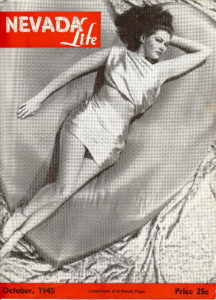
The masthead lists Len Weissman was the Editor and Publisher, Brigham Townsend as the “City Reporter.” Others on the staff included Madge Kennedy in charge of advertising, Jud Wright as the Art Director and John L. Wade as the Circulation Manager.[i]
The business offices were located at 223 Fremont Street, Suite 18, Las Vegas, Nevada. The magazine was published at 552 South Serrano Avenue, Los Angeles, 5 California.
Nevada Life relied on photographs with captions for most of its content.
Comedian Jimmy Durante “reading” the first issue, September, 1945, of Nevada Life.
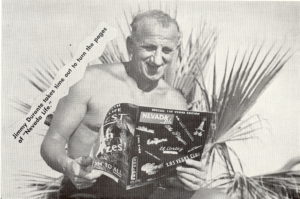
The magazine had one column “Through the Keyhole” which included items promoting the magazine, nightclub and hotel sponsors. No one was listed as the author of the column.
However, by the November, 1945 issue, “Brigham (Young man about) Townsend” is listed as the writer of “Through the Keyhole.”[ii]
The October, 1945 edition contains a “short short story” by Jimmy Durante, titled “I love that town.” Durante writes about Las Vegas. He also posed with a copy of the first issue of the magazine.
By March of 1946 Herb Stoloff was listed along with Townsend as “staff.”
Richard Lingenfelter and Karen Gash, in their book ”The Newspapers of Nevada,” state Nevada Life “was suspended” in May of 1946, and “revived briefly in November.”[iii] This is incorrect, as Nevada Life was “revived” no later than October of 1946 as an issue of that month is known to exist.
By October of 1946, Wess Murray was added to the “staff” list and Stoloff was put at the head of the list followed by Townsend and Murray.
In addition, by October of 1946, Weissman is listed as the Publisher, and the Editor is Art West.
A Fashions department was added in October to the staff list. The Fashions department included Madge Kennedy and Jane Turner. Dave Bergman was added to the Art Department along with Wright, and Wade was still in charge of circulation.
Lingenfelter and Gash, state, Louis Rangno was added as the Editor of the magazine in November of 1946.[iv]
The magazine may not have been published from June to September of 1946 but for some reason the Volume number changed to two.
Under standard procedure, the Volume would have changed on the annual anniversary of the magazine, which would have been September of 1946. However, the know issue of October, 1946, says it is Volume two, and issue number 9. Which would mean that volume two could have started as early as January, 1946, but the March 1946 is listed as volume one.
Other options, the magazine may have been published more frequently in the summer and fall of 1946, or the owners of the magazine changed the volume number because they felt like it, possibly to signify a change in publisher or editor.
At this point the last known issue of Nevada Life is November, 1946. It is possible publication stopped with the November, or the December, 1946 issue.
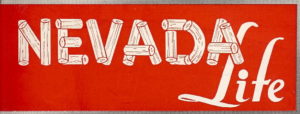
As Nevada Life ended publication at the end of 1946, Las Vegas Life was born. Nevada Life appears to be the predecessor to Las Vegas Life. Both used a similar wooden-log style font for the title to the magazines.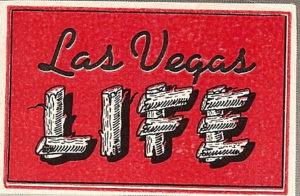
Hank Greenspun arrived in Las Vegas in September of 1946. A month later he decided to make Las Vegas his home and moved his family to the growing community.
Greenspun says, at a point in the late fall of 1946 he “ran into Ralph Pearl, an old buddy from law school, since turned journalist. He was between jobs, and he had a reporter friend, James L. Fallon, equally talented and equally unemployed. The two of them had an idea. [v]
Hank says “they talked, I listened, and the result was another swift impulsive decision: among the three of us, we were going to launch a slick, pocket-sized, five-cent magazine to chronicle the more stimulating aspects of Las Vegas nightlife.” [vi]
Fallon became the Executive Editor, Ralph Pearl became the “Hollywood Correspondent,” and Greenspun said he became the “Publisher also reporter, columnist, and incidentally, the guy who footed the bills” of the magazine. [vii]
Greenspun, who up until an editorial meeting of the new magazine, was Herman Greenspun. At the meeting Fallon started calling Greenspun Hank, as he reminded him of an old friend and baseball player Hank Greenberg. [xiii]
“From that moment on” Greenspun said, “no one in Las Vegas called me anything else.” [xiv]
Pearl says it his idea to call Greenspun Hank, not Fallon. [xv]
Greenspun’s column was called “Gleanings from Glitter Gulch.” [viii]
In 1983, during an interview in his office at the old Las Vegas Sun building on Highland Avenue, which is now Martin Luther King Boulevard, Greenspun said, “Now they talk about Glitter Gulch as if it were a new expression just famed. I had a magazine here in 1946 Las Vegas Life and in that magazine my column “Gleams from Glitter Gulch by Hank.” That was in 1946 and now Glitter Gulch has become one of the slogans of Las Vegas. I wrote that column in 1946.” [ix]
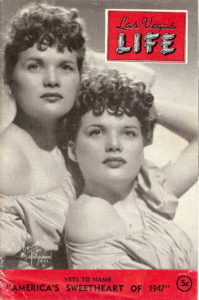
In an interview shortly before he died, Pearl said the idea to start the magazine was his, not Hank’s. A version that Greenspun agrees with.
Yet in Pearl’s book “Las Vegas is My Beat,” he his recollection was slightly different. Pearl says he told Greenspun, “Remember I warned you, you’d be much more successful operating a kosher delicatessen in Butte, Montana, that publishing a magazine in Las Vegas.” [x]
Pearl wrote, “As things turned out, it was one of the rare predictions I would make over the years that would hold up.” [xi]
“Greenspun insisted” Pearl said and “I went along with him.” [xii]
Las Vegas Life started publishing the last week of 1946 and continued into the summer of 1947 In the April 1947 issue, in addition to Greenspun and Fallon, Eleanor Watterud was listed as the “Managing Editor.” [xxix]
From the beginning Hank said, the magazine was “running hip-deep in the red,” and “no matter how many hands I pumped, the level of red ink rose higher and higher.” [xvi]
The publication was printed at the cities only newspaper, the Las Vegas Review Journal.
The newspaper was owned by Don Reynolds, and run by Al Cahlan. Greenspun describes what happened to help pull the magazine “slightly” out of the red. [xvii]
Following a meeting with Cahlan at the newspapers offices Greenspun says he “introduced me to a suave-looking, nattily dressed man whom he called “Mr. Siegel,” there was nothing in his manner to indicate anything out of the ordinary. Viewing that scene, an uninformed onlooker would never have guessed that the Siegel in question was none other than “Bugsy,” the arrogant master-hoodlum. [xviii]
Greenspun described Siegel as a “once handsome but now a rapidly balding forty-two.” [xix]
Greenspun’s meeting with Siegel took place following the ill -fated day after Christmas 1946 opening of the Flamingo.
The opening took place despite the fact that the hotel was not finished. Greenspun said after Siegel lost “hundreds of thousands of dollars the first two weeks” he closed the resort. [xx]
As part of the new public relations campaign, “a minor part” Greenspun said, Siegel “took over the back cover of Las Vegas Life, paying two hundred and fifty dollars per issue.” [xxi]
Pearl says the Flamingo was “one of our biggest, if maybe the only Major advertiser” in Starting off as a weekly Greenspun announced in the March, 1947 issue with an “Editor’s note; Due to the shortage of paper, Las Vegas Life will publish on a monthly only basis until further notice.” [xxx]
Before the Flamingo reopened, Greenspun was “offered a well-paid position on its publicity and public relations staff.” [xxiii]
Greenspun took the job as well as continuing the publication of Las Vegas Life.
Then on June 30, 1947 Siegel was murdered, and shortly after, Greenspun quit the hotel.
“Las Vegas Life was still staggering on, but” said Greenspun “I knew the magazine would soon have to fold. I couldn’t afford to finance it any longer.” [xxiv]
Pearl echoed Greenspun’s reason for the end of Life; “when Bugsy got done in, the magazine folded.” [xxv]
The week that Siegel was killed Pearl said he helped “bury the little literary mess,” adding “our magazine venture last six months and folded with a squish like a deflated balloon.” [xxvi]
Not long after the Las Vegas Life magazine shut down, Hank Greenspun would create the Las Vegas Sun newspaper and successfully complete with the cities only other newspaper the Las Vegas Evening Review-Journal.
And many years later the Greenspun family would create and publish a city magazine under the title “Las Vegas Life.”
In addition to Las Vegas Life, during the 1940’s several small magazines were published, from “Your Friday Hangover” which last several years, to “Las Vegas Guide,” to “Las Vegan” which last through the lasted thought the late 1940’s and into the early 1950’s. It was Jack Cortez and his Fabulous Las Vegas Magazine, started in 1949 that found the right formula and would publish for the next quarter of a century.
[i] staff listing, October, 1945, Nevada Life, page three
[ii] “Thru the Keyhole,” November 1945, Nevada Life, Page eleven.
[iii] “The Newspapers of Nevada,” by Richard Lingenfelter and Karen Gash, 1984, University of Nevada Press, Reno, page 130.
[iv] “The Newspapers of Nevada,” by Richard Lingenfelter and Karen Gash, 1984, University of Nevada Press, Reno, page 130.
[v] “Where I Stand,” by Hank Greenspun, 1966, David McKay Company, Inc. New York, page 69.
[vi] “Where I Stand,” by Hank Greenspun, 1966, David McKay Company, Inc. New York, page 69.
[vii] “Where I Stand,” by Hank Greenspun, 1966, David McKay Company, Inc. New York, page 69.
[viii] “Where I Stand,” by Hank Greenspun, 1966, David McKay Company, Inc. New York, page 69.
[ix] Transcript of interview with Hank Greenspun by Bob Stoldal, in his office at Las Vegas Sun, afternoon of July 13, 1983.
[x] “Las Vegas is My Beat,” by Ralph Pearl, 1973, Lyle Stuart, Inc, Secaucus, N. J., page 187.
[xi] “Las Vegas is My Beat,” by Ralph Pearl, 1973, Lyle Stuart, Inc, Secaucus, N. J., page 187.
[xii] “Las Vegas is My Beat,” by Ralph Pearl, 1973, Lyle Stuart, Inc, Secaucus, N. J., page 187.
[xiii] “Where I Stand,” by Hank Greenspun, 1966, David McKay Company, Inc. New York, page 69.
[xiv] “Where I Stand,” by Hank Greenspun, 1966, David McKay Company, Inc. New York, page 69.
[xv] “Las Vegas is My Beat,” by Ralph Pearl, 1973, Lyle Stuart, Inc, Secaucus, N. J., page 187.
[xvi] “Where I Stand,” by Hank Greenspun, 1966, David McKay Company, Inc. New York, page 69 and 70.
[xvii] “Where I Stand,” by Hank Greenspun, 1966, David McKay Company, Inc. New York, page 70.
[xviii] “Where I Stand,” by Hank Greenspun, 1966, David McKay Company, Inc. New York, page 70.
[xix] “Where I Stand,” by Hank Greenspun, 1966, David McKay Company, Inc. New York, page 70.
[xx] “Where I Stand,” by Hank Greenspun, 1966, David McKay Company, Inc. New York, page 70.
[xxi] “Where I Stand,” by Hank Greenspun, 1966, David McKay Company, Inc. New York, page 70.
[xxii] “Las Vegas is My Beat,” by Ralph Pearl, 1973, Lyle Stuart, Inc, Secaucus, N. J., page 187.
[xxiii] “Where I Stand,” by Hank Greenspun, 1966, David McKay Company, Inc. New York, page 71.
[xxiv] “Where I Stand,” by Hank Greenspun, 1966, David McKay Company, Inc. New York, page 72.
[xxv] “Las Vegas is My Beat,” by Ralph Pearl, 1973, Lyle Stuart, Inc, Secaucus, N. J., page 187.
[xxvi] “Las Vegas is My Beat,” by Ralph Pearl, 1973, Lyle Stuart, Inc, Secaucus, N. J., page 187.
[xxvii] “Where I Stand,” by Hank Greenspun, 1966, David McKay Company, Inc. New York, page 73.
[xxviii] “Where I Stand,” by Hank Greenspun, 1966, David McKay Company, Inc. New York, page 73.
[xxix] Las Vegas Life masthead, April 1947, Las Vegas Life, page Three.
[xxx] “Editor’s Note, March 1947, “Las Vegas Life,” page two.
